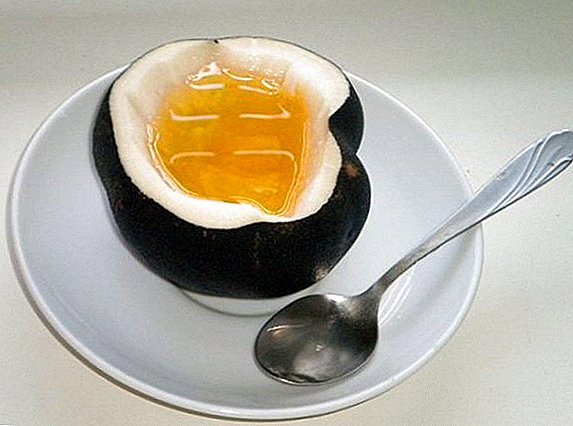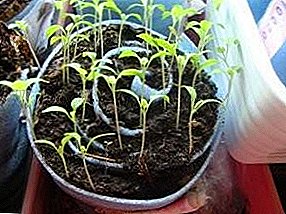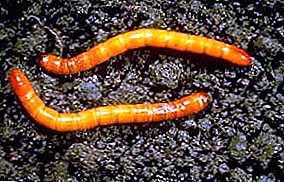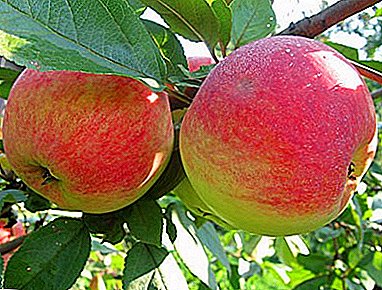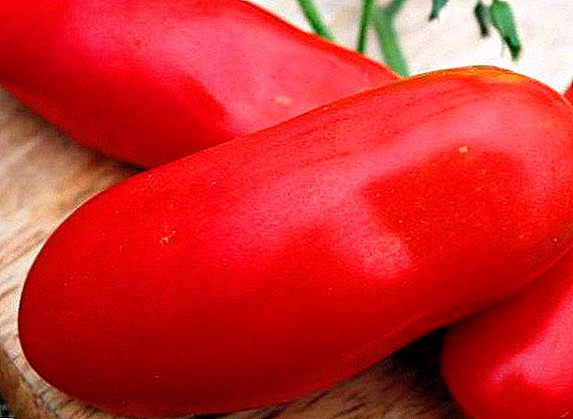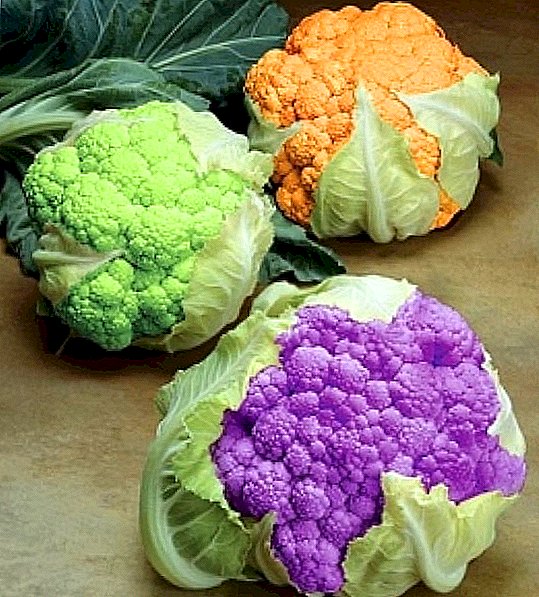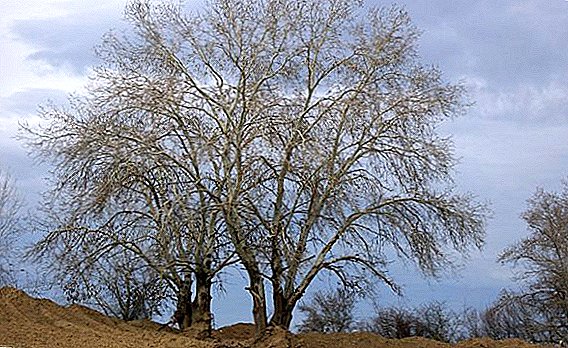 Despite the general resentment of universal poplar fluff, botanists insist on the indispensable benefits of these unpretentious giants. First of all, it is important for megacities and industrial settlements. But besides the fact that the tree performs the function of a powerful biofilter, it also has healing properties, is a good honey plant and a valuable building material. What is a a silvery variety of poplar, what is beneficial for growing, and where it can be applied - read about all this later in the article.
Despite the general resentment of universal poplar fluff, botanists insist on the indispensable benefits of these unpretentious giants. First of all, it is important for megacities and industrial settlements. But besides the fact that the tree performs the function of a powerful biofilter, it also has healing properties, is a good honey plant and a valuable building material. What is a a silvery variety of poplar, what is beneficial for growing, and where it can be applied - read about all this later in the article.
Other names
In botanical sources, the plant is designated by its official name. "white poplar" or the Latin analogue Pópulus álba. But in everyday life this poplar is called silvery, snow-white, false white, which is justified by the coloring of the bark.
Did you know? According to ancient Roman mythology, white poplar has been considered a sacred tree since the time of Hercules. Since then, when Cacus was defeated in a cave overgrown by these giants, Cacus, the poplar branches symbolize victory.
 Also in common use the plant is called "Abele", which is an abbreviation of the Latin word "albellus", meaning "white." In some literature, the names "Poplar Bolle", "Bachofen Poplar" and Latin synonyms are found: White Poplar, Silverleaf Poplar, Silver Poplar.
Also in common use the plant is called "Abele", which is an abbreviation of the Latin word "albellus", meaning "white." In some literature, the names "Poplar Bolle", "Bachofen Poplar" and Latin synonyms are found: White Poplar, Silverleaf Poplar, Silver Poplar.Taxonomy
This majestic plant is a fast-growing deciduous tree belonging to Poplar genus and willow family. In a more detailed description of the white poplar taxon, the botanists indicate the department of the Flowering or Angiosperms of the Malpighieves order.
In addition to white poplar, the willow family also includes willow and its species: weeping, goat, dwarf, spherical and whole-leaved.

Tree description
Characteristic features of the plant is its thick and high trunk of a light color, wide pyramidal or rounded crown. These are well-known signs by which the tree is easily recognized. Let us consider its description in more detail.
Barrel bark
Tree develops in height to 16-30 m. Compared with a wide crown that starts low from the ground, the trunk seems very short. Its maximum length is 1.5-2.5 m. At the base it is thick, and closer to the middle of the crown it branches into equivalent shoots.
Did you know? After three hundred years of cultivation of white poplar, the plant was banned in Connecticut. The reason for this was the massive pollinosis caused by down. In addition, in many states, wood is considered an ecological weed.

Young seedlings have smooth bark that rather resembles a smoky plaque of felt. Mature trees are distinguished by the longitudinally fissured surface of the trunk of a light silver or slightly greenish color. Old trees can be recognized by deep cracks and dark bark, which very often becomes black.
Leaves
In spring, small, leaf-shaped, egg-shaped buds appear on the branches of white poplar. And on the old branches they are bare and glossy, and on young ones they are covered with slight pubescence. From them there is a foliage of various forms. Some specimens may be deltoobraznye, others - oval, egg-shaped, multipartic. Combines all this extravaganza of forms dense structure, size and color sheet plates. From above they are dark green and smooth, and from the bottom - silver-felt. Closer to November foliage becomes bright yellow, it can turn brown in the rainy season. But the feature of the Abel is that the fall of the leaves begins with a green crown. On average, each leaf reaches up to 12 cm in length and up to 10 cm in width. It is attached to the branch by a short cylindrical stem.
Did you know? Depending on the cultivation conditions and various environmental factors, poplar can change the sex from female to male and vice versa.

Flowers
Depending on the climatic conditions, the tree blooms in the last weeks of April-early May. Often this period coincides with the blooming of foliage.
Among the inflorescences of the plant, which are earrings up to 8 cm long, botanists distinguish between male and female samples. The first ones are characterized by gray color and bright terracotta stamens, and the second ones - by green-gray coloring. Besides allergens are just trees with female flowers. After pollination, seeds are formed in them, which by summer completely mature. 
Fruit
Achenes have the shape of a narrow cone. In the first phases of development, they are distinguished by a bright green color and a smooth structure. To the extent of maturation, their color acquires light brown shades. In late summer, the seed pods turn completely dark. They clearly see a pair of number of valves, from which small grains with specific long fibers at the base pour out. 
Root system
Typical signs of the silver poplar root system are power and tallness. It develops depending on the physico-chemical characteristics of the soil. In wet areas, the fibrous roots are located in the surface layers, and in loamy and sandy areas, they deepen as far as possible, reaching for moisture. At the bottom of the trunk often appears young shoots. It can also be found at a fairly considerable distance - 20 m from the mother tree.
Some features
In fact, silver poplar has many unique characteristics. Consider the most interesting of them.
Average height width
These trees are considered by many to be giants. The highest poplars reach a height of 60 meters. In our latitudes copies below 19 m are not found. The diameter of the old trunk can reach two meters in width, and the crown is drawn up to 35 m. 
In urban conditions, such features of white poplar are very much appreciated. Indeed, according to the doctor of biological sciences of the National Botanical Garden named after N.N. Grishko of the National Academy of Sciences of Ukraine Peter Bulakh, the plant develops quickly and easily adapts to sharp temperature changes and growing conditions. In addition, due to the upward-moving branches and the highly elongated crown, there is space saving and simultaneous purification of large volumes of air polluted by automobile exhausts. The scientist says that poplar foliage is able to absorb even metal-containing dust and is the leader in the list of trees according to the intensity of atmospheric filtration.
Did you know? After poplar, chestnuts and lindens are among the top three environmental cleaners.

Growth rate
When you look at tall poplars, it seems that to such heights they grow forever. And, it turns out, the growth rate of silver and other varieties is recorded only in the first fifty years. Older trees slow down their development, and in 10–20 years they stop growing.
Once on fertile soils, pyramidal silver poplar reaches its maximum height as early as 25 years of age. From the moment of landing it grows annually upwards by 1 m and in breadth by 40 cm
Now you can imagine the speed with which metabolic processes occur in the fabric fibers of wood. It is very viable and can revive even when the trunk breaks during a hurricane.
Lifespan
Loggers often joke that trees live until they are allowed on firewood and planks. In this black humor, of course, there is some truth. But if you do not take into account the poplar felling, the lifespan of a poplar is measured in centuries. Today scientists say that many trees have survived. more than 400 years but there are also 600-year-old giants. 
Important! Poplar trees do not like to compete for space for their roots, and also differ in aggressive distribution. That is why they are not recommended to land closer than 15 m from buildings. The root system of the plant can destroy underground and drainage facilities, as well as the foundations of buildings and drain soils. Poplar becomes especially dangerous on clay plots.
Growing conditions
Scientists constantly talk about the good survival rate of the silver look. Let's see what is the most suitable culture for a comfortable growing season.
Distribution and habitat
Today, Abel is known about poplar on all continents without exaggeration. The tree can be seen in the subtropical, Mediterranean, temperate continental and temperate climatic stripes. Its habitat is almost the entire territory of Eurasia, not including Scandinavia. Wild thickets are found near water bodies, in riverine forests, floodplains, oxbows and valleys. In the steppe zones it is comfortable for them to grow on lightly saline soils. And in rocky areas, these giants can climb a thousand-meter height above sea level. 
Often, they coexist with a moisture-loving black variety of poplar, elm, alder, tamarisk, but can be placed alone.
Soil, moisture requirements
Fertile, moist, light substrates with good drainage and neutral acidity are an ideal place for unpretentious false white poplar. But in the absence of such a good, the plant can be content with slightly acid and alkaline soils, endure arid sandstones, heavy loams, and even will find vitality on silt and rubble.
Important! The tree is very sensitive to pruning.The plant fully satisfies the nearby rivers and lakes or groundwater. Moreover, the root system does not suffer from prolonged flooding at all. But the drought tolerance of the tree is average.

Lighting Requirements
Perhaps this is the only categorical condition that is vital for sun-loving tree. It loves a lot of ultraviolet light and needs it. It can adapt to the penumbra, but in such conditions its growth will slow down. Although, judging by the size of the poplar, the shadow does not threaten him.
Frost resistance
Botanists celebrate high resistance of plants to low temperatures. It can easily overwinter at -30 ° C.
Spruce, birch, larch, Siberian cedar pine, aspen, juniper, willow, elm and oak, as well as white poplar, frost-resistant trees that have the ability to tolerate short frosts.

Breeding
To get a new plant seedling is very simple. In tropical regions, this process is possible by the seed method, and in temperate climatic zones, vegetative reproduction of silver poplar is more practiced. It is carried out by grafting or separation of root growth. We will understand the subtleties in more detail.
Important! Poplar seeds lose their usefulness after a year. The best conditions for their storage are cold and low humidity.If you like botanical experiments and are a fairly patient and optimistic person, then you can take a chance with sowing seeds. But just be ready that the best germination from them immediately after collection. It was then that you need to harvest peat pots and carry out sowing.

This is done in wet substrate. When sowing seeds outdoors, a bed is desirable, without waiting for shoots, to be covered with a thin layer of straw mulch. The material will retain moisture and protect the grain from weathering and leaching by rain.
When seedlings appear, provide them with good lighting. After all, in the shade they will be strongly drawn out, become thin and fragile. Such conditions can destroy sprouts in the first days after germination.
Experts advise to give preference to the seedling method using peat pots or tablets. In this case, you will not need to separate the young shoots into individual containers. But if this is not done, leaving the poplar seedlings to be crowded on the garden, all efforts will be in vain. The idea will not succeed, because the root system of the tree does not like to compete for space, food, moisture and sun. 
Important! When cutting off cuttings, make sure that each of them has 2-3 leafy buds.Of the vegetative breeding methods, grafting is the easiest. To obtain a new seedling, it is necessary to prepare planting material in March. This is usually done for mass landings, therefore, a whole bunch of apical branches are cut, after which they are tied up and put in a bouquet in a jar of water. By the way, liquids need up to half the capacity. Then everything is cleaned in the fridge until planting. As a rule, it occurs in the second decade of April.
The process itself consists in planting blanks in such a way that two thirds of them are buried under the ground, and 1 kidney is required in the above-ground part. A month later, there will be small roots. For this it is important to monitor the moisture in the soil.
Root separation - complex and troublesome procedure. Often, it ends in failure, due to damage to the young seedling during separation from the maternal root. 
Decorative forms
Beautiful non-standard green-silver coloring of foliage and light bark of white poplar give it an unusual decoration. The tree is beautiful at all times of the year. That is why it is often used in landscape gardening design to create compositions, framing alleys.
Did you know? Each hectare of fifteen-year-old Abele plantations produces more than 200 m³ of wood.The tree fits nicely into the architecture of water areas, it can grow in combination with other plants that differ sharply in color and alone.

Among the most popular decorative forms of the silver variety are:
- globosa - is a medium-growth tree with densely arranged in the form of a wide oval branches and small foliage;
- weeping (pendula) - differs by a low trunk and branches drooping down;
- Richard (Richardii) - it is characterized by a yellow coloring of a glossy surface;
- snow white (var.nivea) - looks spectacular due to the snow-white back of the leaves, which contrasts with the silver surface.
Application and properties
White poplar is not only a spectacular decoration of large parks and coastal zones, but also an excellent honey plant, a healing tool for people and animals, as well as valuable building material. Let's find out in detail what is the secret of the uniqueness of the plant. 
Landscape quality
Under the conditions of megacities compactness of a volume krone is appreciated. The plant is often used as a fire protection, strengthening of coastal zones. This contributes to the high resistance of the culture to strong sea winds. But, unfortunately, this ability deteriorates after the age of ten.
People have learned to take advantage of the aggressiveness of the roots of white poplar. That is why it can often be seen on sand dunes near water bodies.
Important! In case of mass plantings of a silver variety of poplar, it is recommended to observe the distance between the trunks of 3 m, and for multi-row layouts, these should be between the rows, and after 5 m they plant a new seedling.

Medicinal properties
If you take an entire silver poplar tree, its foliage, bast and outer layers of wood are considered edible. According to scientists, the leaf plates are valuable through containing vitamin C, dried bast can be added to flour for baking bread, and the bark relieves pain, inflammatory processes, has a disinfectant, diuretic, astringent and tonic effect.
Salicylates were found in the surface parts of the poplar stem, which are the active substance of many painkillers, including aspirin.
Pharmacology makes extensive use of the plant bark for the manufacture of a number of medical preparations for rheumatism, gout, arthritis, lumbar pain, dysfunction of the digestive tract, fever, anorexia, menstrual pain, general weakening of the body. 
ethnoscience advises many recipes using poplar raw materials for the treatment of purulent non-healing wounds, abscesses, diseases of the oral cavity, hemorrhoids and frostbite.
Important! Some growers are advised to use the cold extract from the leaves and young branches of white poplar as a growth promoter. The solution is made by soaking finely chopped raw materials in ordinary water for a day.
Medonos
When the poplar is in bloom, bees flock to its branches from everywhere. The fact is that the tree gives good pollen bribes. Beekeepers note that silver poplar is only a little inferior to linden by its melliferous characteristics. Pollen from males to females is spread by the wind. And even during the flowering period, many grumble, complaining about allergies caused by poplar fluff, but it is absolutely impossible to get rid of the tree. This echo and environmentalists, and the owners of bee colonies, and herbalists. 
Wood use
This material is different softness, lightness and kruplovernostyu. It is easy to work with him. Inside the wood is characterized by a clear yellow core. In old specimens it becomes brown and hard. Sapwood is less durable compared to it. It contains a lot of moisture that attracts fungi, insects. As a result, this part of the tree is often loose.
In the timber industry, white poplar is recycled for making paper, pulp, turning and joinery, boards, plywood, parquet, lumber, building sheathing, packaging materials. 
In addition, the bark of the plant has found its application. Ее широко употребляют для получения жёлтой краски и дубления кожи.
But the greatest value of white poplar is ability to purify the air and release large amounts of oxygen. These qualities are much stronger than temporary troubles associated with fluff flying everywhere. And only female copies spread it, and only male ones are introduced into the culture.


